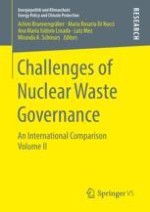2018 | Book
Challenges of Nuclear Waste Governance
An International Comparison Volume II
Editors: Dr. Achim Brunnengräber, Dr. Maria Rosaria Di Nucci, Ana María Isidoro Losada, Dr. Lutz Mez, Prof. Dr. Miranda A. Schreurs
Publisher: Springer Fachmedien Wiesbaden
Book Series : Energiepolitik und Klimaschutz. Energy Policy and Climate Protection
